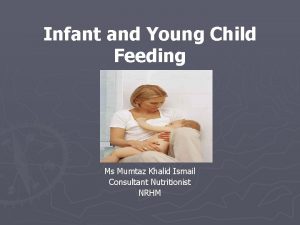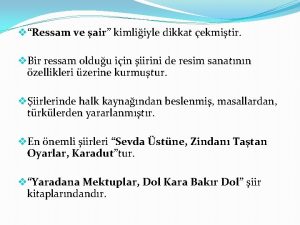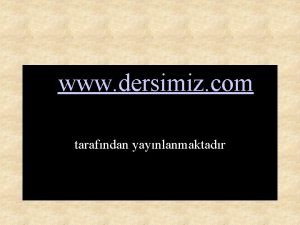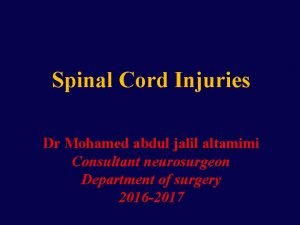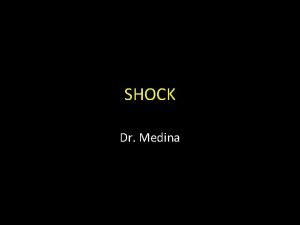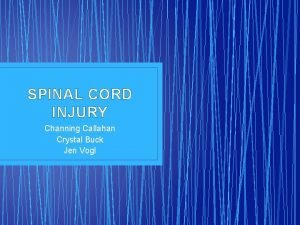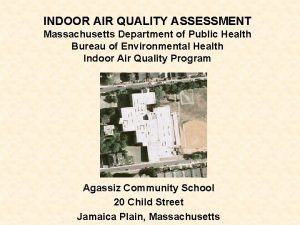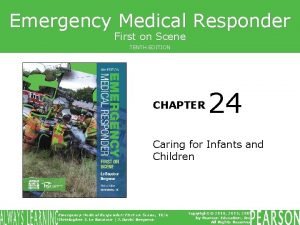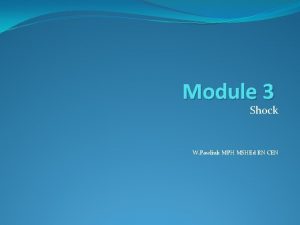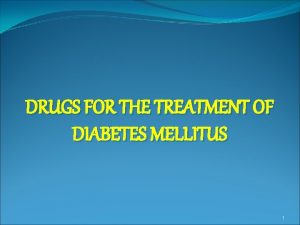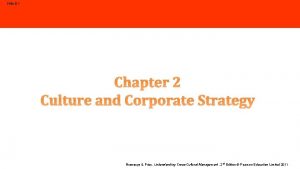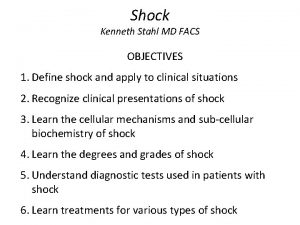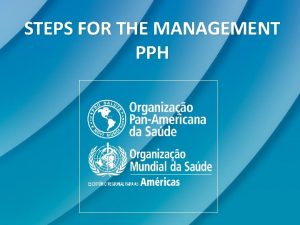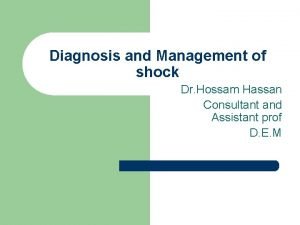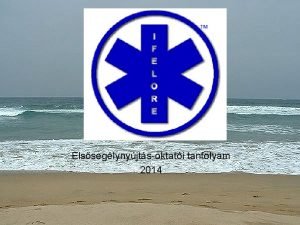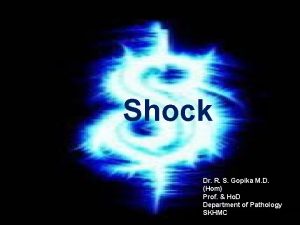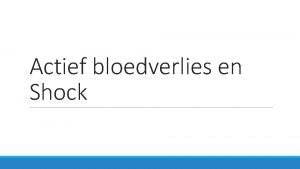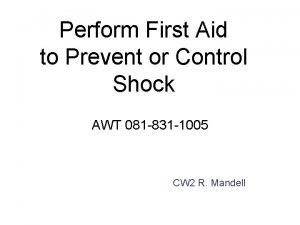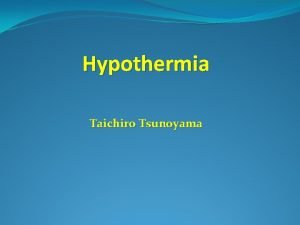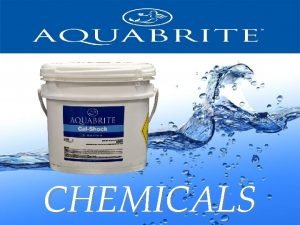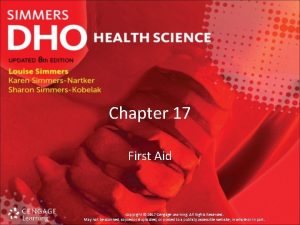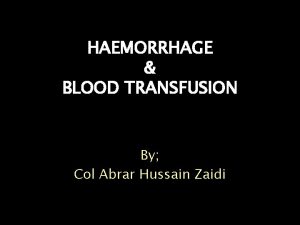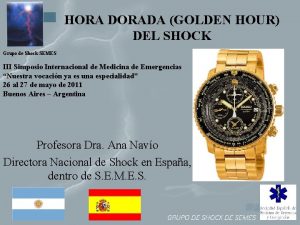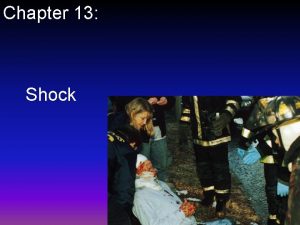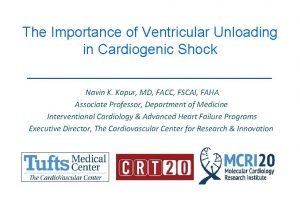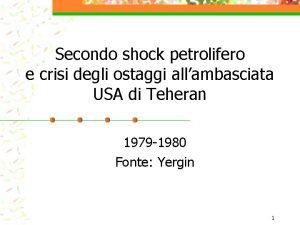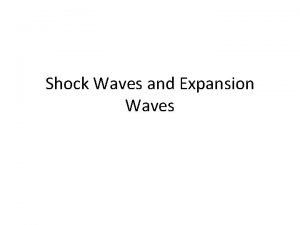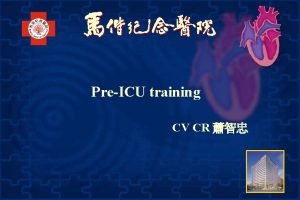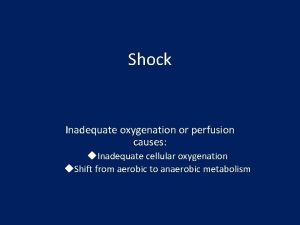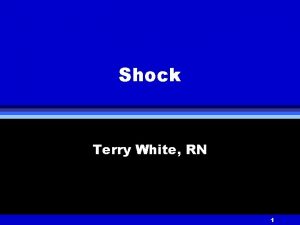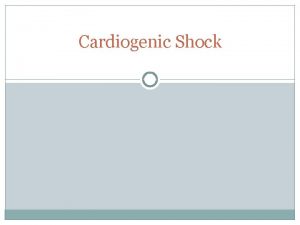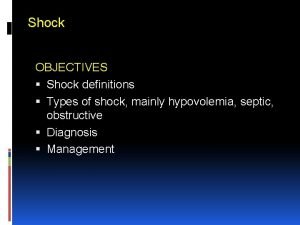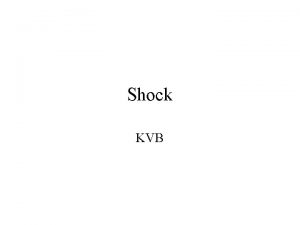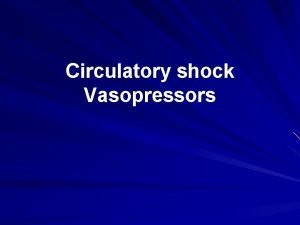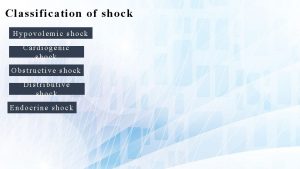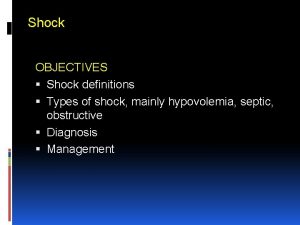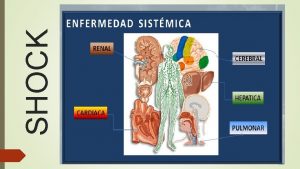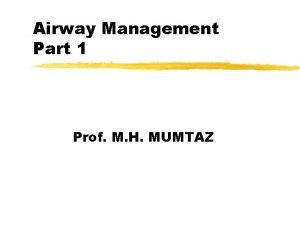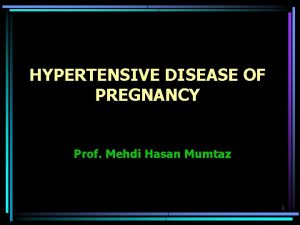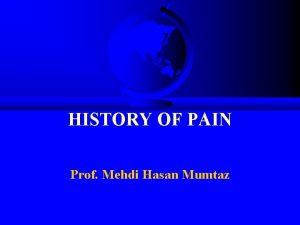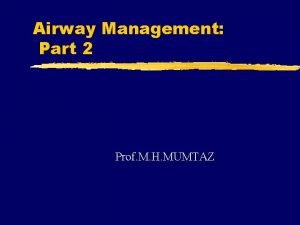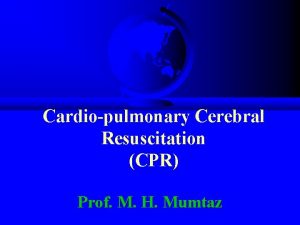SHOCK Prof M H MUMTAZ 1 SHOCK Inadequate


























































- Slides: 58

SHOCK Prof. M. H. MUMTAZ 1

SHOCK Inadequate perfusion (blood flow) leading to inadequate oxygen delivery to tissues 2

Physiology l l Basic unit of life = cell Cells get energy needed to stay alive by reacting oxygen with fuel (usually glucose) No oxygen, no energy No energy, no life 3

Aerobic Metabolism 6 CO 2 6 O 2 METABOLISM GLUCOSE 6 H 2 O 36 ATP HEAT (417 kcal) 4

Anaerobic Metabolism 2 LACTIC ACID GLUCOSE METABOLISM 2 ATP HEAT (32 kcal) 5

Anaerobic? So What? Inadequate Cellular Oxygenation Inadequate Energy Production Metabolic Failure Anaerobic Metabolism Lactic Acid Production Cell Death! Metabolic Acidosis 6

Homeostasis is maintenance of balance l Requires proper functioning systems • Cardiovascular • Respiratory • Renal 7

Cardiovascular System l l Transports oxygen, fuel to cells Removes carbon dioxide, waste products for elimination from body Cardiovascular system must be able to maintain sufficient flow through capillary beds to meet cell’s oxygen and fuel needs 8

Flow = Perfusion Adequate Flow = Adequate Perfusion Inadequate Flow = Indequate Perfusion (Hypoperfusion) Hypoperfusion = Shock 9

What is needed to maintain perfusion? l l l Pump Heart Pipes Blood Vessels Fluid Blood 10

How can perfusion fail? l l l Pump Failure Pipe Failure Loss of Volume 11

Factors Affecting The Pump l l Preload Contractile force • Frank-starling mechanism l Afterload

Muscle Anatomy 13

Contraction: Sliding Filaments image from: http: //www. accessexcellence. com/AB/GG/muscle_Contract. html 14

What Is Blood Pressure? BP = COx. SVR CO = Stroke Volume X Heart Rate SVR= B. vessel calibre +viscosity

What Affects Blood Pressure? l l ANS balance Contractility • Preload • Starling’s law l Afterload 16

Types of Shock and Their Causes CARDIOGENIC HYPOVOLAEMIC SEPTIC NEUROGENIC PSYCHOGENic obstructive ANAPHYLACTIC 17

Cardiogenic Shock l l Pump failure Heart’s output depends on • How often it beats (heart rate) • How hard it beats (contractility) l Rate or contractility problems cause pump failure 18

Cardiogenic Shock l Causes • Acute myocardial infarction • Very low heart rates (bradycardias) • Very high heart rates (tachycardias) Why would a high heart rate caused decreased output? Hint: Think about when the heart fills. 19

Neurogenic Shock l l l Loss of peripheral resistance Spinal cord injured Vessels below injury dilate What happens to the pressure in a closed system if you increase its size? 20

Hypovolemic Shock l l Loss of volume Causes • Blood loss: trauma • Plasma loss: burns • Water loss: Vomiting, diarrhea, sweating, increased urine, increased respiratory loss If a system that is supposed to be closed leaks, what happens to the pressure in it? 21

Psychogenic Shock l l l Simple fainting (syncope) Caused by stress, pain, fright Heart rate slows, vessels dilate Brain becomes hypoperfused Loss of consciousness occurs What two problems combine to produce hypoperfusion in psychogenic shock? 22

Septic Shock l l Results from body’s response to bacteria in bloodstream Vessels dilate, become “leaky” What two problems combine to produce hypoperfusion in septic shock? 23

Anaphylactic Shock l l l Results from severe allergic reaction Body responds to allergen by releasing histamine Histamine causes vessels to dilate and become “leaky” What two problems combine to produce hypoperfusion in anaphylaxis? 24

OBSTRUCTIVE SHOCK PUMONARY EMBOLISM ? CRDIAC TEMPONADE ? PNEUMOTHORAX ? 25

Shock: Signs and Symptoms l l Restlessness, anxiety Decreasing level of consciousness Dull eyes Rapid, shallow respirations l l l Nausea, vomiting Thirst Diminished urine output Why are these signs and symptoms present? Hint: Think hypoperfusion 26

Shock: Signs and Symptoms l l Hypovolemia will cause • Weak, rapid pulse • Pale, cool, clammy skin Cardiogenic shock may cause: • Weak, rapid pulse or weak, slow pulse • Pale, cool, clammy skin l l Neurogenic shock will cause: • Weak, slow pulse • Dry, flushed skin Sepsis and anaphylaxis will cause: • Weak, rapid pulse • Dry, flushed skin Can you explain the differences in the signs and symptoms? 27

Shock: Signs and Symptoms l Patients with anaphylaxis will: • Develop hives (urticaria) • Itch • Develop wheezing and difficulty breathing (bronchospasm) What chemical released from the body during an allergic reaction accounts for these effects? 28

Shock: Signs and Symptoms Shock is NOT the same thing as a low blood pressure! A falling blood pressure is a LATE sign of shock! 29

Treatment l l l l Secure, maintain airway Apply high concentration oxygen Assist ventilations as needed Keep patient supine Control obvious bleeding Stabilize fractures Prevent loss of body heat 30

Treatment l l Elevate lower extremities 8 to 12 inches in hypovolemic shock Do NOT elevate the lower extremities in cardiogenic shock Why the difference in management? 31

Management of Shock l l l Shock begins when DO 2 to the cells is inadequate to meet metabolic demand The major therapeutic goals in shock therefore are sufficient tissue perfusion and oxygenation Early diagnosis remains a major problem 32

Treatment l Administer nothing by mouth, even if the patient complains of thirst 33

Hemodynamic Characteristics in Different Types of Shock Type Preload Hemmorrhagic LOW Anaphylactic LOW Cardiogenic HIGH Septic (Hyperdynamic ) LOW Septic (Hypodynamic) LOW CO PVR SVR / 34

Inotropic Agents and Vasodilators l l l Vasoactive drugs are an important pharmacologic defense in the treatment of shock. May be required to support BP in the early stages of shock. These agents may be needed to: • Enhance CO through the use of inotropic agents • Increase SVR through the use of vasopressors 35

Effects of Inotropic Agents and Vasodilators Drug Receptor Epinephrin a 1 , b 1, (b 2) e Norepinep a 1, b 1 hrine Dopamine b 2, DR, (a) Dobutamin b 1, b 2 e Dopexamin b 1, b 2, DR e CO SVR Dose Range 0. 02 – 0. 5 0 - 0. 05 – 0. 5 2 -12 2 - 12 0 - 0 - 0. 9 - 5 (mg/kg/min) 36 1

Effects of Inotropic Agents and Vasodilators Drug CO SVR Dose Range Nifedipine 0 - 0. 5 - 10 Nitroglycerin 0 - 3 -5 Nitroprusside 0 - 0. 5 - 5 Prostacyclin 10 - 40 (mg/kg/min) 37 2

Dopamine An endogenous precursor of norepinephrine with multiple dose-related effects l Low Dose (0. 5 - 3 mg/kg/min) • b 2 and dopaminergic (DR) effects • Enhanced blood flow to renal and splanchnic beds l Moderate Dose (5 -10 mg/kg/min) • Positive inotropic effects l High Dose (>20 mg/kg/min) • a-actions (vasoconstriction) 38

MANAGEMENT GUIDE l 1, Haemodynamic monitoring Blood pressure/HR SV, HR, CI, CO SVR, SVRI TOOLS ; SWAN GANZ TEMPERATURE LIDCO CENTRAL VENOUS PRESSURE 2, OXYGENATION STATUS FIO 2/PAO 2/Pa. O 2/DO 2/VO 2/ Lactate 3, ACID BASE STATUS 39

HAEMODYNAMIC TRUTHS l l l 1, TACHYCARDIA IS NEVER AGOOD THING. 2, HYPOTENSION IS ALWAYS PATHOLOGIC 3, THERE IS NO SUCH THING AS NORMAL CARDIAC OUTPUT. 4, CENTRAL VENOUS PRESSURE IS ONLY ELEVATED IN DISEASE. 5, PERIPHERA EDEMA IS OF COSMETIC CONCERN. PINKSY. . Chest. 2007; 132; 2020 -2029 40

Bleeding 41

Bleeding Significance l If uncontrolled, can cause shock and death 42

Identification of External Bleeding l Arterial Bleed • Bright red • Spurting l Venous Bleed • Dark red • Steady flow l What is the physiology that explains the differences? Capillary Bleed • Dark red • Oozing 43

Control of External Bleeding l Direct Pressure • gloved hand • dressing/bandage l l Elevation Arterial pressure points 44

Arterial Pressure Points l l Upper extremity: Brachial Lower extramity: Femoral 45

Control of External Bleeding l Splinting • Air splint • Pneumatic antishock garment 46

Control of External Bleeding l Tourniquets • Final resort when all else fails • Used for amputations • 3 -4” wide • write “TK” and time of application on forehead of patient • Notify other personnel 47

Control of External Bleeding l Tourniquets • Do not loosen or remove until definitive care is available • Do not cover with sheets, blankets, etc. 48

Epistaxis l l Nosebleed Common problem 49

Epistaxis l Causes • Fractured skull • Facial injuries • Sinusitis, other URIs • High BP • Clotting disorders • Digital insertion (nose picking) 50

Epistaxis l Management • Sit up, lean forward • Pinch nostrils together • Keep in sitting position • Keep quiet • Apply ice over nose • 15 min adequate 51

Epistaxis can result in lifethreatening blood loss 52

Internal Bleeding l Can occur due to: • Trauma • Clotting disorders • Rupture of blood vessels • Fractures (injury to nearby vessels) 53

Internal Bleeding Can result in rapid progression to hypovolemic shock and death 54

Internal Bleeding l Assessment • Mechanism? • Signs and symptoms of hypovolemia without obvious external bleeding 55

Internal Bleeding l Signs and Symptoms • Pain, tenderness, swelling, discoloration at injury site • Bleeding from any body orifice 56

Internal Bleeding l Signs and Symptoms • Vomiting bright red blood or coffee ground material • Dark, tarry stools (melena) • Tender, rigid, or distended abdomen 57

Internal Bleeding l Management • Open airway • High concentration oxygen • Assist ventilations • Control external bleeding • Stabilize fractures • Transport rapidly to appropriate facility 58
 Mumtaz baby food
Mumtaz baby food Negotiation decoy
Negotiation decoy Aruza veda kimin eseri
Aruza veda kimin eseri Iqra mumtaz
Iqra mumtaz Sayılardan sonra sıra bildirmek için kullanılır
Sayılardan sonra sıra bildirmek için kullanılır Javaid aziz ibm
Javaid aziz ibm Site:slidetodoc.com
Site:slidetodoc.com Subacute combined degeneration of the cord
Subacute combined degeneration of the cord Shock normovolemico
Shock normovolemico Spinal shock vs neurogenic shock
Spinal shock vs neurogenic shock Spinal shock symptoms
Spinal shock symptoms Who am i to be brilliant gorgeous talented fabulous
Who am i to be brilliant gorgeous talented fabulous Inadequate cmdb risk
Inadequate cmdb risk Why is scholasticism inadequate
Why is scholasticism inadequate Inadequate competition
Inadequate competition Define inadequate
Define inadequate Inadequate vent ionizer
Inadequate vent ionizer Shock prof
Shock prof Hypovolumic
Hypovolumic Anaphylactic shock hemodynamics
Anaphylactic shock hemodynamics Culture shock adalah
Culture shock adalah Unit 15:9 providing first aid for bone and joint injuries
Unit 15:9 providing first aid for bone and joint injuries Decompensated shock
Decompensated shock Neurogenic shock
Neurogenic shock Diabetic shock vs coma
Diabetic shock vs coma Culture shock pyramid
Culture shock pyramid Classes of shock
Classes of shock Rings comfort device
Rings comfort device Compensated shock
Compensated shock Shock index
Shock index Hypovolemic shock grade
Hypovolemic shock grade Distributive shock
Distributive shock Rautek műfogás
Rautek műfogás Shock normovolemico
Shock normovolemico Anaphylactic shock
Anaphylactic shock Hoeveel bloed heeft een mens
Hoeveel bloed heeft een mens Perform first aid to prevent or control shock
Perform first aid to prevent or control shock Toxic shock syndrome
Toxic shock syndrome Rewarming shock
Rewarming shock Aquabrite a plus stain remover
Aquabrite a plus stain remover 17:8 providing first aid for cold exposure
17:8 providing first aid for cold exposure Duchscher transition shock model
Duchscher transition shock model Atls classes of hemorrhagic shock
Atls classes of hemorrhagic shock Shock absorber tester
Shock absorber tester Hora dorada en sepsis
Hora dorada en sepsis Shawn dowling
Shawn dowling What is the mains supply
What is the mains supply Compensated shock
Compensated shock Dengue shock syndrome
Dengue shock syndrome Cardiogenic shock algorithm
Cardiogenic shock algorithm The moon glowed like
The moon glowed like Anti shock trousers
Anti shock trousers Secondo shock petrolifero
Secondo shock petrolifero Prandtl meyer expansion
Prandtl meyer expansion Bow shock
Bow shock Pcwp shock
Pcwp shock William schnettler
William schnettler Why were the nuns’ faces “pinched with displeasure”?
Why were the nuns’ faces “pinched with displeasure”? Osmotic shock
Osmotic shock
